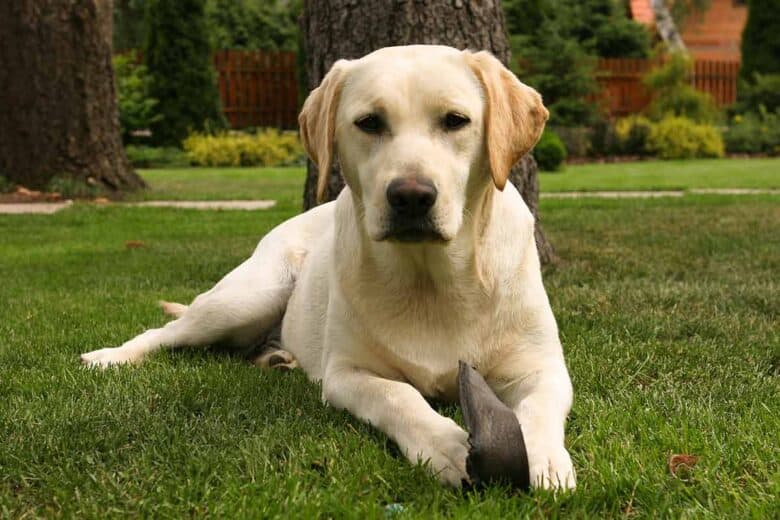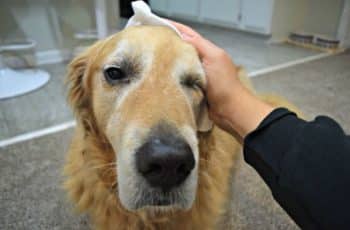This post may contain affiliate links. We may earn money or products from the companies mentioned in this post.
If you own a female Labrador retriever or are planning on getting one, you need to understand how their heat cycle works.
One of the most common questions I get is: “How often do Labs go into heat?” Followed by, “When do Lab puppies have their first heat?”
Knowing what to expect when your Labrador goes into heat for the first time is important.

Caring for your dog when she is in season can be challenging, mainly because your Lab can become pregnant in mere moments, leaving you to figure out what to do with a litter of puppies.
One of the biggest problems owners of female Labs face is preventing unwanted pregnancies.
To avoid dealing with unwanted puppies, you must know when your female Labrador can become pregnant and come up with a plan to protect your dog from unwanted pregnancies.
Keep on reading to learn when Labs go into heat, what a heat cycle looks like, and what to expect from it.
Contents & Quick Navigation
When Do Labs Go Into Heat For The First Time?
Labrador retrievers, like all other dogs, will have their first heat cycle when they reach puberty.
As your female Lab grows, there will come a time when her body will become ready to mate, become pregnant, and give birth to a litter of puppies. When that time comes, it is usually referred to as their first heat or first season.
Most dogs reach puberty and have their first heat cycle around six months of age, but this can vary depending on the breed. Most large dog breeds go into heat a bit later than smaller breeds, as their bodies need more time to grow and mature properly.
As a large dog breed, your female Lab will probably go into heat for the first time somewhere between 9 and 12 months of age.
However, this isn’t set in stone, and some dogs can have their first heat anywhere between one and two years of age. If your girl is a late bloomer, there’s probably nothing to worry about.
Our black lab, Elsa went into heat last December at almost exactly 6 months old.
How Often Do Labs Go Into Heat?
After your Lab’s first heat, their cycle usually follows a regular schedule. In a sense, your dog’s heat cycle is similar to what human females go through every month with their menstrual cycles, except not as often. Instead of going into heat every month, most female Labrador retrievers go into heat every six months after their first heat cycle.
Since all dogs are different, this pattern can vary a bit from one Lab to the next. It’s not uncommon for some female Labrador retrievers to go into heat only once a year, while some go into heat every three to four months!
Two heat cycles a year is merely an average for Labrador retrievers. As long as the Labrador’s heat cycle is regular and follows a consistent pattern, you don’t have anything to worry about. For example, an 8 to 10 months heat cycle is slightly longer than the norm, but it is not abnormal or worrisome in any way.
However, if your Lab’s heat cycle is irregular and doesn’t follow a predictable schedule, you should consult with your veterinarian.
Inconsistent or extremely late heat cycles can indicate underlying health problems and are best discussed with a vet. Also, any sudden changes in your dog’s cycle can be a sign of health issues that require medical attention.
It’s been 10 months since Elsa’s first heat cycle and we’re still waiting for her second one. Tick Tock!
Signs Of A Lab In Heat
While most experienced owners can spot when their Labs are going into heat, this whole process can be slightly confusing for first-time owners. If you’ve never owned a dog before and your Lab’s first heat cycle is approaching, here are the signs to look out for:
Swollen Vulva
This is probably the biggest and most obvious sign that your Lab is in heat. When entering her heat cycle, your Labrador’s vulva or genitalia will become immensely swollen.
I’m not talking about a bit of swelling here; your dog’s vulva will be three to four times bigger than its normal size. The swelling makes a huge difference to the appearance of your Lab’s vulva and is hard to miss once you know what to look for.
Bleeding
Most dog owners prepare themselves for a significant amount of bleeding for their dog’s first heat cycle. However, they are usually pleasantly surprised when they discover that their Labs don’t bleed a lot at all. In some cases, you may even miss the bleeding if you aren’t paying close attention.
A female Lab in heat will typically only leave a few drops of blood behind, usually on their bed or somewhere on the floor.
I’ve found that dog diapers are a great way to keep the bleeding contained and away from furniture and floors. To be completely sure that your Labrador is in heat, use a tissue and wipe her vulva. If there is a red discharge and your dog’s vulva is swollen, it’s a clear sign that your Lab is going into heat.
Our Golden Retriever, Raven bleeds very little during her heat cycles. However, our Labrador Retriever, Elsa bled much more and it was fairly messy. We use dog diapers with Elsa.
Increased Self Cleaning
Labrador retrievers are clean animals regardless of their heat cycle, and your dog is probably meticulous about her grooming routine. However, during their heat cycles, female Labs become even more preoccupied with their cleanliness.
If you notice your Labrador is licking and cleaning herself a lot more than usual, chances are that she’s trying to remove and hide the blood.
This is usually my number 1 sign for for a lab in heat. I always notice the excessive cleaning and it’s at that time when I check to see if she has a swollen vulva.
Behavioral Changes
With all the extra hormones flowing through your Lab’s body, she is bound to behave differently than usual. Depending on how these hormones affect her, your pooch may become more needy and clingy a few days before her other physical symptoms start to show.
Most Labradors become sleepier then usual and are in the mood for extra cuddles. However, some females might get more excitable and restless, depending on how the hormonal changes are affecting them.
Humping & Flagging
Some female Labs might hump other dogs, toys, and even people when they go into heat. Since humping is a playful behavior in puppies, you should only consider it as a sign of a heat cycle if your dog is exhibiting excessive humping along with other symptoms.
When in heat, your Lab may also move her tail to the side and expose her rear end more often than usual. This type of behavior is called flagging, and it signals to nearby male dogs that your Lab is ready for mating. Flagging most often happens during the third stage of the heat cycle when a female is completely receptive to males.
Admirers
When female Labs go into heat, they produce pheromones that attract male dogs of any breed. Sometimes, you don’t have to observe your dog for signs of heat, as other dogs can be a much better indicator of your Lab’s heat cycle.
You may notice that male dogs are frequenting your yard more often than before, basically waiting to pounce on your pooch as soon as she leaves the house. Since dogs have an incredible sense of smell, male dogs can smell a female in heat from miles away.
How Long Does A Female Labrador Stay In Heat?
Most female Labrador retrievers stay in heat for 2 to 4 weeks. However, this isn’t set in stone, and a slightly shorter or longer heat cycle is not uncommon. About 10 days into her heat cycle, your Lab will ovulate, which means her body will release eggs that can be fertilized.
A clear sign that your Labrador is ovulating is when her discharge changes color from a bright or dark red to a light pink color. During ovulation, your pooch will also start moving her tail from the side and flagging more to signal to males that she is ready for mating.
How long each stage of the heat cycle lasts varies among dogs and depends on a lot of factors. Since it’s extremely hard to tell at what stage of the heat cycle your dog is, you should assume that your Lab can get pregnant at any time.
To avoid wondering whether your Lab is pregnant or not, you will need to look after her like a hawk when she goes into heat or risk unwanted puppies.
Understanding The Four Stages Of Lab Heat Cycle
The heat cycle of any dog, including the Labrador retriever, consists of different hormonal changes that happen based on a regular schedule. A lab’s heat cycle consists of four distinctive stages during which her body produces hormones that will affect her fertility throughout the year.
Knowing when female Labs go into their heat cycle and understanding the different stages of it can help you look after your dog more responsibly.
Being aware of everything your Lab is going through will also prepare you for the many behavioral and physical changes your Lab will experience during heat so there won’t be any strange surprises.
Observe your Lab closely to learn the specific signs of her heat cycles. Doing this will give you a better idea of what to expect in terms of the length of the cycle, amount of discharge, behavioral changes, and more. If you are considering breeding your Labrador, you should wait until her third heat to breed her.
Listed below are the four stages of the Labrador heat cycle and what you can expect to happen during each phase.
Proestrus
Proestrus is the first stage of your Lab’s reproductive cycle and is the time when your dog will begin to go into heat. On average, this stage lasts around nine days, during which time your dog’s uterus is preparing for a possible pregnancy.
When it comes to physical signs, your dog’s vulva will become swollen, and there will be a bloody discharge.
During the proestrus stage, your Lab’s estrogen levels will peak, and male dogs will be more attracted to her than usual. However, most females aren’t receptive to males at this stage and will dismiss their advances.
Estrus
Estrus is the second stage of a Labrador retriever’s heat cycle. This stage usually lasts nine days, and at this time, female dogs are more receptive to males. Your Labrador is fertile now since she is ovulating, and she can easily become pregnant at this stage.
During the estrus stage, your dog’s vulva is still enlarged but softens a little, and her bloody discharge becomes pink. Your dog’s estrogen levels are dropping, and her progesterone levels are starting to rise.
Since your Lab is most fertile during this time, she will let male dogs mount her and may even try to seek them out. If you aren’t planning to breed your female Labrador, you’ll need to be extra careful during this stage of her heat cycle.
It’s not uncommon for dogs to escape their kennels, dig holes under fences, or jump walls to mate, so keep a close eye on your Lab.
Diestrus
Diestrus is the third stage of a dog’s reproductive cycle during which female Labs are no longer receptive to males. This stage usually lasts around two months. At this time, your Lab’s estrogen levels are low, while the progesterone peaks three to four weeks after the start of diestrus and then goes back to normal levels.
The change of progesterone levels at this stage will happen whether or not your Labrador is pregnant. Depending on what happened during the estrus stage, your female Labrador is either pregnant during diestrus or is in a period of rest.
Anestrus
Anestrus is the time between diestrus and the next proestrus. This stage usually lasts four months, but it can be longer for certain breeds.
At this stage, your female Labrador is no longer in heat, nor does she show any signs of heat. It’s worth mentioning that your dog is no longer fertile in this stage, so she won’t be attractive to male dogs or be interested in them.
During anestrus, your Lab’s vulva will no longer be swollen, and there won’t be any discharge. Your Labrador retriever and her body will use this time to allow her uterus to recover and prepare for the next possible pregnancy.
These four stages repeat every heat season, and your dog may go through them once or twice per year. Keep in mind that all dogs are different, and some Labradors may not experience or show the exact changes outlined above.
If you notice any changes to your Lab’s heat cycle or have any questions or concerns, don’t hesitate to talk with your veterinarian.
FAQs About When Female Labs Go Into Heat
How do you know when your Lab is in heat?
There are several clear signs that your female Labrador retriever is in heat. The most common signs of heat in Labradors are a swollen vulva, the presence of bloody discharge, increased licking of the genital area, and swollen nipples.
When it comes to behavioral changes, you may notice your Lab is acting clingier than before. She may be more excitable or more lethargic and sleepy than usual depending on how the hormonal changes affect her.
Some Labs while in heat may also hump other dogs, toys, and people and start flagging during the estrus stage. Observe your Lab and pay attention to her behavior to learn the specific signs of her cycle.
How long do Labs bleed in heat?
Most female Labradors bleed for anywhere from 7 to 10 days while in heat. Despite common beliefs, dogs don’t actually bleed a lot, and you may not even realize your Lab is bleeding in the first place unless you’re paying close attention.
Even if you do notice she is bleeding, chances are you’ll only ever spot a few drops of blood near your dog’s bed or on the floor.
How long does a Lab’s first heat last?
The length of your Lab’s first season may vary. The first heat, on average, lasts anywhere from 2 to 4 weeks, and this varies slightly amongst individual dogs.
After her first heat, your Lab should go into season once or twice a year regularly for the rest of her life. Keep in mind, while it’s not recommended to breed Labs before their third heat, females can still get pregnant during their first heat cycle.
What is the best age to spay a female Labrador?
The best time to spay your female Labrador is when she is beyond 11 months of age and weighs more than 45 pounds. While some people opt to spay their Labs before their first season, it’s better to wait after the first heat cycle to give your dog time to grow and develop properly.
When do male Labs go into heat?
Unlike female Labs who go into heat one or two times a year, male Labs don’t go into heat. Instead, male dogs can mate all year round once they reach puberty and become fertile at around six months old.
Once they reach sexual maturity, a male Lab can mate up to five times a day and will sense any nearby female dogs who are in heat.
Conclusion
Knowing how often Labs go into heat can help you keep your dog safe and prevent unwanted pregnancies.
As an owner of a female Labrador, you will need to take all the necessary measures to keep your girl away from persistent suitors; otherwise, you may end up with a surprise litter on your hands.
Most female Labs go into heat once or twice a year and exhibit the following signs:
- Swollen and enlarged vulva
- Dark or bright red bloody discharge
- Excessive licking of the genital area
If you don’t plan to breed your Labrador retriever, I strongly encourage you to consider spaying your dog when the time is right. This way, you won’t have to worry about unwanted puppies and certain diseases.
Has your female Lab come into her first heat? Were you able to keep your girl protected against the onslaught of male dogs?
Share your experience dealing with your Lab’s heat season with us and our readers in the comment section below!
Save To Pinterest

Top Picks For Our Dogs
- BEST PUPPY TOY
We Like: Snuggle Puppy w/ Heart Beat & Heat Pack – Perfect for new puppies. We get all of our Service Dog pups a Snuggle Puppy. - BEST CHEW TOY
We Like: KONG Extreme – Great toy for heavy chewers like our Labrador Retrievers. - BEST DOG TREATS
We Like: Wellness Soft Puppy Bites – One of our favorite treats for training our service dog puppies. - BEST FRESH DOG FOOD
We Like: The Farmer’s Dog – A couple months ago we started feeding Raven fresh dog food and she loves it! Get 50% off your first order of The Farmer’s Dog.
For a list of all the supplies we get for our new service dog puppies check out our New Puppy Checklist on the PuppyInTraining.com blog.
How Often Do Labs Go Into Heat – Lab Heat Cycle Explained was last modified: September 27th, 2021 by


